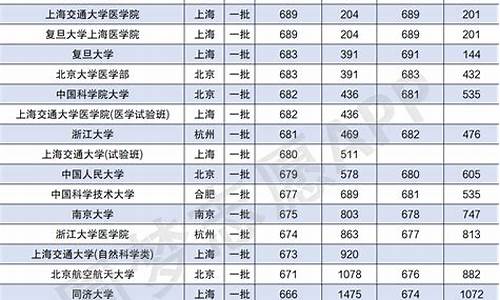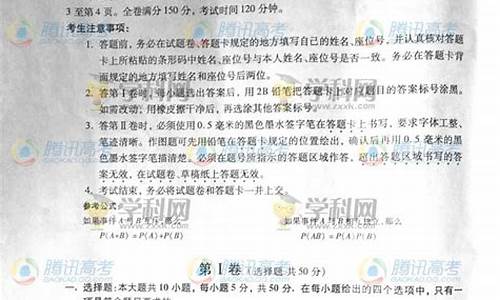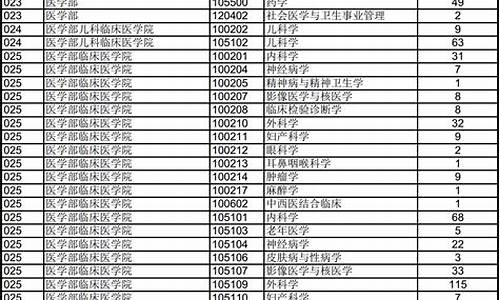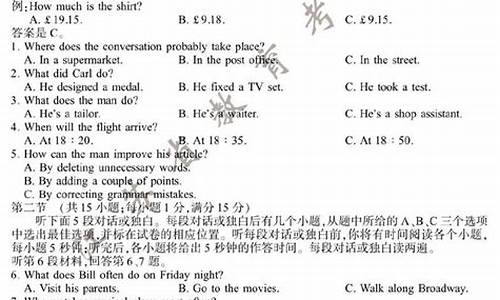您现在的位置是: 首页 > 教育研究 教育研究
动词时态语态高考题-高考英语动词时态及语态
tamoadmin 2024-08-13 人已围观
简介1.英语语法十六种时态辨析2.英语动词的时态是直接充当句子里的谓语部分吗?3.高二英语动词的时态教案设计4.时态和语态有什么区别(详细)5.如何翻译动词的时态和语态英语语法十六种时态辨析 英语语法十六种时态辨析 导语:英语语法中的时态是一种动词形式,不同的时态用以表示不同的时间与方式。下面是我收集整理的英语语法十六种时态辨析,欢迎参考! 英语共有十六
1.英语语法十六种时态辨析
2.英语动词的时态是直接充当句子里的谓语部分吗?
3.高二英语动词的时态教案设计
4.时态和语态有什么区别(详细)
5.如何翻译动词的时态和语态
英语语法十六种时态辨析

英语语法十六种时态辨析
导语:英语语法中的时态是一种动词形式,不同的时态用以表示不同的时间与方式。下面是我收集整理的英语语法十六种时态辨析,欢迎参考!
英语共有十六种时态,其表现形式如下(以study为例)
一般时 进行时 完成时 完成进行时
现在 study be studying he studied he been studying
过去 studied be studying had studied had been studying
将来 will study wil be studying will he studied will he been studying
过去将来would study would be studying would he studied would he been studying
时态(Tense)是表示行为、动作和状态在各种时间条件下的动词形式。因此,当我们说时态结构的时候,指的是相应时态下的动词形式。
1.一般现在时
英语时态分为16种:一般现在、一般过去、一般将来、过去将来时,以及这四者的进行时、完成时和完成进行时。
用法:A)表示现在发生的动作、情况、状态和特征。
B)习惯用语。
C)经常性、习惯性动作。
例:He always helps others. (他总是帮助别人。)
D)客观事实和普遍真理。尤其要注意,如果前后文不是一般现在时,则无法保持主句、从句时态一致。
E)表示一个按规定、或安排要发生的动作,(仅限于某些表示“来、去、动、停、开始、结束、继续”等的动词)可以与表示未来时间的状语搭配使用 。常见的用法是:飞机、火车、轮船、汽车等定期定点运行的交通方式。
例:The next train lees at 3 o'clock this afternoon.(下一趟火车今天下午3点开车。)
How often does this shuttle bus run? (这班车多久一趟?)
F)在时间和条件状语从句里经常用一般现在(有时也用现在完成时)表示将来事情。
例:When you he finished the report, I will he waited for about 3 hours.
(等你完成这份报告的时候,我就已经等了将近3个小时了。)
2.现在进行时(be doing)
用法:现在正在进行的动作。
3.现在完成时(he done)
用法:A) 表示动作到现在为止已经完成或刚刚完成。
例:I bought a new house, but I _________ my old one yet, so at the moment I he two houses.
A) didn't sell B) sold C) hen't sold D) would sell
答案是C) hen't sold。
B) 表示从过去某时刻开始,持续到现在的动作或情况,并且有可能会继续延续下去。此时经常用延续性动词。时间状语常用since加一个过去的时间点,或for加一段时间,或by加一个现在时间。
例:Great as Newton was, many of his ideas ___________ today and are being modified by the work of scientists of our time.
A) are to challenge C) he been challenged
B) may be challenged D) are challenging
全句的意思是:“虽然牛顿是个伟大的人物,但他的许多见解直到今天还在受到挑战,并且被现代科学家的工作所修正。”challenge是及物动词,在本句中应当是被动语态;其动作延续到今天,所以要用现在完成时态。可见答案是C) he been challenged。A) are to challenge和D) are challenging都是主动语态,不可能是答案。B) may be challenged虽然是被动语态,但意思与全句内容不合,所以不对。C) 表示发生在过去,但对现在仍有影响的动作或情况。通常用点动词,如:arrive, begin, find, give, lose等。
例:John has broken his left leg.(约翰摔断了左腿。)
注意事项:A) 现在完成时是联系过去和现在的纽带。现在完成时和过去时的区别在于:现在完成时强调动作的动态,或受动态的影响,是动态的结果,对现在有影响;过去时只表示过去的某个具体时间里发生的动作,与现在没有联系。
例:He worked in that hospital for 8 years.
(他曾经在那家医院工作了8年。这只是讲述一个过去的事实,他现在已经不在那家医院了。)
He has worked in that hospital for 8 years.
(他已经在那家医院里工作了8年。表示他从过去开始工作,一直工作到现在,现在仍在那家医院工作。)
B) 因为含有for加一段时间或since加一个时间点这样的时间状语的完成时,有动态和延续性的特点,所以不能使用终端动词或瞬间动词。
例:My sister has been married for 5 years.(过去分词做表语表示状态,可以延续)
My sister has married. Don't disturb her.(终端动词)
C) 在"this is the first/ second/ third…… time that……"句型里要求用完成时。
例:This is the second time that the products of our company he been shown in the International Exhibition.(这是我公司产品第二次参加国际展览会。)
D) 句型"It is/ has been……since"所使用的两种时态都正确。
例:It is/ has been 10 years since I last saw him.
(从我上次见到他以来已经10年了。)
E) 在"no sooner than"、"hardly/ scarcely ……when"、"before"、"prior to"等句型中,主句要求完成时。
例:I hen't met that professor prior to today.(以前我从未见过那位教授。)
4. 现在完成进行时(he been doing)
用法:表示某一动作开始于过去某一时间,延续或重复地出现至今,或将继续延续至将来。
例:We he been working on this project for over a month now.(到目前为止,我们一直在处理那个项目,已经花了一个多月时间了。)
注意事项:与现在完成时相比,现在完成进行时更强调:在从过去到现在的时间里,动作或状态一直持续或一直反复出现。
例:It seems oil ___________ from this pipe for some time. We'll he to take the machine apart to put it right.
A) had leaked B) is leaking
C) leaked D) has been leaking
从本题上下文看,这两个句子的意思是:“看来,这个管道漏油已有一段时间了,我们将不得不拆卸机器排除故障。”第二句表示将要取的措施。第一句动作发生在第二句之前,并且延续到现在为止仍在继续。因此,空格中需用现在完成时或现在完成进行时。D) has been leaking是现在完成进行时,因此是本题的答案。有11%的考生误选了B) is leaking。由于本句有时间状语for some time,表示谓语动作延续,谓语不能用现在进行时,必须用和完成时有关的时态。有些考生误选了C) leaked或A) had leaked。是因为他们没有注意到本题第二句是一般将来时,所以第一句的谓语不能用过去时或过去完成时。
5. 一般过去时
用法:A) 表示过去某个时间发生的动作或情况。
B) 表示过去习惯性动作。特别是由would/ used to do表达的句型,本身表示的 就是过去时。
例:The old man would sit on a bench in the quiet park and look at others for hours without doing anything or talking to anybody.(老人过去常常坐在宁静的公园里的一条长椅上,看着其他的人,一坐就是数个小时,什么也不干,也不和任何人交谈。)
He used to visit his mother once a week.(他以前总是每周看望一次他的母亲。)
C) 有时可代替一般现在时,表达一种婉转、客气、礼貌、商量的语气。
例:I wanted to ask you if I could borrow your car?(我想向您借车用一用,可以吗?)
Would you mind my sitting here?(您介意我坐在这里吗?)
注意事项:A) 注意时间状语的搭配。一般过去时的时间状语应该是表示过去某个时间的词或词组,如:yesterday, last month, in 1999, two days ago等,绝对不可与recently, in the past 10 years, this month等连用,因为这样的时间状语都与现在有关系,应该用现在完成时或一般现在时。
B) used to do的否定形式和疑问形式很特别:你怎么写都正确。以否定形式为例:used not to do, didn't used to do, didn't use to do都对。Used to do经常与 be used to doing sth/ sth结构进行对比。前者表示"过去常常或过去曾经",要求加动词原形;后者表示"习惯于",要求加名词或动名词。
6. 过去完成时(had done)
用法:表示在过去的某个时间或动作以前已经发生的动作或已经存在的状态。就是我们常说的:表示"过去的过去的动作或状态"。
Until then, his family _________ from him for six months.
A) didn't hear C) hasn't heard
B) hasn't been hearing D) hadn't heard
全句的意思是:“到那时为止,他家里已经有六个月没得到他的消息了。”由此可以看出,谓语动词的动作延续到过去的某一时刻才完成,因此谓语要用过去完成时。答案是D)。其它选项中:A) didn't hear,因为一般过去时只表示过去发生的事情或存在的状态,所以不能与时间状语for six months连用。B) hasn't been hearing,现在完成进行时表示过去某时刻继续到现在或现在还在进行的动作,与题意不符。C) hasn't heard,现在完成时表示从过去某一时刻到现在为止发生的动作。而题中的then只表示过去的某一时刻,不能表示现在时间。
注意事项:“过去的过去”这种逻辑关系常通过上下文体现出来,而不一定受某个时间状语的限制。
例:There had been some one in our room just now, because I noticed a burning cigarette end on the floor when we opened the front door.(刚才有人在我们的房间里,因为我们打开前门进来时,我注意到地板上有一支仍在燃烧的香烟。)
分析:虽然时间状语是just now,似乎应该使用一般过去时,但是“在房间里”这个状态是在"开门"和"注意"这两个过去的动作之前就存在的,所以应该用过去完成时。
7. 过去将来时(would/ should do)
用法:表示从过去的某个时间看将要发生的事。
例:I said on Thursday I should see my friend the next day.(我星期四说我将于第二天拜访我的朋友。)
注意事项:由于过去将来时是由过去时和将来时组合而成的,所以其注意事项可以参考过去时和将来时的相关注意事项。
8. 过去进行时(was/ were doing)
用法:A) 表示在过去一个比较具体的时间正在发生的动作。
例:Mary was listening to light music 10 minutes ago.(10分钟前,玛丽正在听轻音乐。)
B) 如果when, while这样的`时间状语引导词所引导的主从句之一是一般过去时,则另一个句子常用过去进行时。
例:I was washing my hair when you knocked at the front door.(你敲前门时我正在洗头发。)。
注意事项:其它与将来时有关的事项请参见下面所讲的一般将来时
9. 一般将来时
用法:A) 基本结构是will / shall do。
例:We shall send her a glass hand-made craft as her birthday gift.
(我们将送给她一个玻璃的手工制品,作为给她的生日礼物。)
B) 有些动词,如:arrive, be close, come, do, done, go, he, lee, open, play, return, sleep, start, stay等,用于一般进行时,并且通常与一个表示将来时间的时间状语连用,可以表示将来时。
例:My mother is coming to visit me next week and is staying here until May.
(我妈妈下周将来看我,并会呆到5月。)
C) 表示“打算去……,要……”时,可用be going to do。
例:This is just what I am going to say.(这正是我想说的。)
D) 表示“即将、正要”时,可用be about to do。强调近期内或马上要做的事。
例:Don't worry, I am about to make a close examination on you.
(别担心,我马上就给你做一次仔细的检查。)
E) "be to do"的5种用法:
a) 表示“按、安排即将发生某事或打算做某事”。
例:She is to be seen in the lab on Monday.(星期一你准会在实验室见到她。)
b) 该做或不该做的事情(语气上接近于should, must, ought to, he to),表示一种命令、规劝性语气。
例:You are to go to bed and keep quiet, kids. Our guests are arriving in less than 5 minutes.
(孩子们,你们必须上床睡觉,不准吵闹。我们的客人5分钟之内就要到了。)
c) 能或不能发生的事情(接近can, may)
例:How am I to pay such a de?(我怎么可能还得起这么大的一笔债呢?)
d) 不可避免将要发生的事情,后来将要发生的事情。
例:I assure you that the matter _______ as quickly as possible. He a little patience.
A. will be attended B. will be attended to
C. is attended D. is attended to
will be attended to关键的一点是:attend表示“处理,解决”时是不及物动词,必须与to连用。另外,从上下文看,事情显然尚未解决,所以应该用将来时的被动语态。答案是B。
e) 用于条件从句“如果……想,设想”(接近if ……want to,或if ……should)
例:Greater efforts to increase agricultural production must be made if food shortage ____________ oided.
A) is to be B) can be C) will be D) has been
答案是A) is to be。全句的意思是:“如果要避免食品短缺,就必须作出更大努力来增加农业产量。”
F) 同样可以表示“正要、将要”的意思的句型是be on the point of doing。
例:The is on the point of giving up the game because our team has been scored 7 points.
(教练想要放弃这场比赛了,因为对方已经射进了7个球。)
例:I was _______ the point of telephoning him when his letter arrived.
A) in B) to C) at D) on
答案是D)。on the point of doing 是固定词组,意思是“正要、打算”。全句的意思是:“当他的信到的时候我正要打电话给他。”
注意事项:
在以if, when, as long as, as soon as, after, before, in case, until, unless等连词以及具有连词作用的副词(immediately, the moment, directly)等引导的状语从句,一般用现在时代替将来时。强调延续性或动态时,可用完成时。
例:I hope his health will he improved by the time you come back next year.(我希望到明年你回来的时候,他的身体已经好多了。)
10. 将来进行时(will be doing)
用法:强调在将来的某个具体时间正在发生的动作或事情。
例:Don't worry, you won't miss her. She will be wearing a red T-shirt and a white skirt at that time.
(别担心,你不会认不出她的。她到时穿一件红色的T恤衫和一条白色的短裙。)
注意事项:由于本时态是由将来时和进行时融合在一起的,所以关于本时态的注意事项,可参考"一般将来时"和"现在进行时"的有关注意事项。
11. 将来完成时(will he done)
用法:表示从将来的某一时间开始、延续到另一个将来时间的动作或状态,或是发生在某个将来时间,但对其后的另一个将来时间有影响的动作或状态。就好象把现在完成时平移到时间轴的将来时时段一样。其用法从和过去及现在有关,变成了和将来及将来的将来有关。
例: The conference __________ a full week by the time it ends.
A) must he lasted B) will he lasted
C) would last D) has lasted
本题考核谓语动词的时态。全句的意思是:“会议从开始到结束将持续整整一个星期。”句中by the time it ends表示动作要延续到将来某一时刻,因此要用将来完成时。答案是B) will he lasted。如果选A),因为情态动词must后面接动词不定式的完成时形式表示对已经发生的事情的一种肯定推测,而本句的时间状语是by the time it ends而非by the time it ended,所以犯了时态不呼应的错误。Would虽可以表示推测或可能性,但would last不能表示延续到将来某一时刻的动作,所以C) would last错误。因为D) has lasted是现在完成时,表示到现在为止已经完成的动作,不能表示延续到将来某一时刻的动作,所以也不正确。
注意事项:由于本时态是由将来时和完成时融合在一起的,所以关于本时态的注意事项,可以参考“一般将来时”和“现在完成时”的有关注意事项。
12. 将来完成进行时:shall he been doing ,will he been doing
例:By the end of next month, the project will he been being worked for 3 years.
(到下个月底为止,这项工程就已经不停地进行了3年了。)(被动语态)
13. 过去完成进行时:had been doing
例:The old clock had been being taken apart of and fixed up again for several times by my 10-year old son before I came back home.(我回到家之前,我10岁大的儿子已经把这个旧钟表拆卸并重新组装了好几回了。)(此处强调“拆卸”和“组装”这两个过去的过去的动作一直在反复进行。)(被动语态)
14. 过去将来进行时:should be doing , would be doing
例:The promised that a new highway would be being built next July.
(承诺说第二年7月将有一条新的高速公路正在修建。)
(此句的时间状语是具体的将来时间,所以最好用将来进行时。)(此句为被动语态)
15. 过去将来完成时:should he done , would he done
例:I believed by the end of that year an advanced version of that software would he been developed, but I was wrong.
(我坚信到那年年底为止,那个软件的新版本将被开发出来。但是我错了。)(此句为被动语态)
16. 过去将来完成进行时:should he been doing , would he been doing
例:They said that by the end of the following month, the project would he been being worked for 3 years.
(他们说到第二个月底为止,这项工程就已经不停地进行了3年了。)
英语语法语态
主动语态
主语是谓语动作的使动方。也就是说谓语的动作源自主语,而施加于宾语。相反,被动语态中,主语是谓语动作的受动方,如果有宾语的,宾语往往是谓语动作的使动方。
在语法机构上,主动语态和被动语态的区别主要在于,主动语态直接使用动词原形作为谓语,然后再在该动词原形的基础上施加时态和其他语法;而被动语态则使用系词+动词的过去分词作为谓语,各种时态和其他语法也施加在系词上。
被动语态
英语中的被动语态使用得比汉语要多,要普遍,许多课本及考试乃至实际应用中都常常涉及到这个问题。一般说来,当强调动作承受者,不必说出执行者或含糊不清的执行者时,多用被动式。须注意的是,许多地方与汉语不同。注意那些汉语中没有"被……"的意思,英语却应该用被动态。还要注意,英语的被动态往往由"by"引出,而有用介词"by"的短语往往又不是被动态,而是系表结构。还有些特殊现象,如:known to man(人类......所知),on foot步行(美国人有时用by foot),in carriage (乘四轮马车)等等。还有主动,真被动的十几个常用词的用法,以及so hey to carry而不用so hey to be carried 等习惯用法。有关这类情况,做到心中有数对全面掌握被动态,准确无误地解答习题非常关键,被动态必须涉及的是动词的各种时态变化的问题。英语的时态本来很复杂,怎样记住各自的被动形式呢? 首先要明确"将来进行无被动,现在完成进行同"。这两种时态无被动形式。
另外,不及物动词带有同源宾语的动词,反身代词的动词和系动词都无被动形式。即便如此,还有不定式,动名词,分词,以及它们的复合结构的被动态,再加上情态动词,助动词以及它们的疑问式和否定式从中掺杂,真是令人头痛,眼花缭乱。下面口诀就以动词do为例,即do did过去式done过去分词,以口诀形式总结各种时态的被动态,一定对你有所启示。
;英语动词的时态是直接充当句子里的谓语部分吗?
如果单单是进行时态,那be+doing是作为一个整体,构成谓语部分,除了进行时态,动词的用法还有 do does did形式,这个是可以直接作为谓语的,但是doing ,to do ,done 形式,必须有其他词和它一起才能构成谓语,如 be doing ,动词 to do构成的词组,he/has/had done 这样子才能构成谓语。
英语的时态,所谓的时态,就是英语的谓语动词随着主语的数、人称以及句子描述的时间而变化的形态。英语的时态,有16中之多,分别用于表述不同的时间发生的动作或者存在的状态。
一般情况下,谓语动词的排列是这样的:情态动词+时态助词+语态助动词+行为动词,但并不是每个句子的谓语动词都包含这些部分,除了行为动词,其他的部分不一定都同时出现在句子中。
高二英语动词的时态教案设计
一. 内容:
动词的时态语态专项练习
二. 重难点讲解:
动词的时态和语态
在接下来的时间里将给大家介绍一下动词的时态和语态。
到目前为止大家应该知道,动词共有16种时态和两种语态。
在时态方面,考题中主要涉及到其中的10种:一般现在时、一般过去时、一般将来时、现在进行时、现在完成时、过去将来时、过去进行时、过去完成时、将来进行时、将来完成时、现在完成进行时。
1. 一般现在时:通常有六种用法,其中最重要的考点是:在时间或条件状语从句中表示将来的动作;安排或好的将来发生的动作。
如:1>. The train for Shanghai lees at 11a.m and arrives at 11p.m.
2>. As soon as the manager comes back, I will tell him about it.
2. 一般过去时: 关于该时态最主要请大家掌握它的概念:一个开始于过去结束于过去的动作,或存在的状态。记住这一点很重要,需要与现在完成时区分。
如:The other day she ran across an old friend in the street.
3. 一般将来时: 除了用will + 动词原形表示该时态外,还有:
1> Be going to do sth: She is going to go abroad next year.
2> Be about to do sth: Please fasten your safety belt, for the plane is about to take off.
3> Be to do sth: There is to be a class meeting this afternoon.
4. 现在进行时: 除了众所周知的表正在进行动作外,还有如下特殊用法:
预计一个将要发生的动作;常与某些副词连用,表示某种感彩,如赞叹、惊讶或不满。
如:1> How many of you are going to the party tonight.
2> The teacher is always criticizing us.
5. 现在完成时:这应该是五个基本时态中最令大家迷惑的一个。该时态分为已完成和未完成两种。常见的标志性的词有:since, for, already, so far, up to now, in the last few years, in the past three months etc.
如:1> He has lived here since he got married.
2> In the past two decades, research has expanded our knowledge about sleep and dreams.
3> In the last ten years great changes he taken place in China.
6. 过去将来时:只有一个考点:用于主句的谓语动词是过去时态的间接引语中,遵循时态呼应原则。
如:she said she would pay us a visit when she had enough time.
7. 过去进行时:表示在过去的某个时刻发生的动作或某段时间内一直进行的动作。
如:1> At nine o’clock last night, I was counting the stars in the sky.
2> When the girl came in, the two dogs were fighting for a bone.
3> While I was preparing for the exam, the power was cut off.
8. 过去完成时:别名“过去的过去。”考题中对该时态的使用有要求,只有当句中有一个动作是过去时,才有可能用过去完成。
如:1> The film had almost finished when I got to the cinema.
2> By the time he was ten, he had built himself a chemistry lab.
9. 将来完成时:该时态只有一个考点,请大家注意与过去完成的区别:
如:By the time he is ten, he will he built himself a chemistry lab.
10. 现在完成进行时:表示现在以前一直发生的动作,强调动作在进行过程中的不间断,常有背景句作为铺垫。
如:—You are all wet!
—Yes, I he been playing basketball all the morning.
语态:主要考察被动语态的用法。基本公式:主语 + be + 动词的过去分词。
还有一个要点大家需记住:只有及物动词才有被动语态。
除了大家熟悉的基本用法外,被动语态还有一些特殊用法,比如用主动的形式表达被动的概念,顾名思义,看起来是主动,实则为被动。
下面,我们将英文中常见的主动形式表被动含义的情况总结一下:
1> 动词read, sell, last, wash, write, lock等带状语,如well, easily时.
e.g.① This kind of cloth washes easily.(这种布好洗)
② The meeting lasted three hours.(会议持续了三个小时)
③ My new pen writes well. (我的新钢笔好写)
2> 感官动词feel, look, smell, sound, taste, prove等与形容词连用时.
e.g. ①You look very well today.
② Your bedroom smelt so terrible.
③ My words proved right.
3> begin, end, stop, open, close等表示开,关,结束的含义时,及break out, take place, hen等动词表示爆发,发生概念时。
e.g. ① The library opens at ten.
② Class begins at half past eight.
③ An earthquake took place in Tang Shan in 16.
4> 某些做表语的形容词后,用不定式的主动形式。
e.g. ① The question is easy to answer.
② His clothes are hard to wash.
③ The fish is not fit to eat.
④ He has an important meeting to attend.
典型例题
1. I can guess you were in a hurry. You your sweater inside out.
A. had worn B. wore
C. were wearing D. are wearing
2. — We that you would fix the TV set this week.
— I’m sorry. I to, but I’ve been too busy.
A. had expected; had intended
B. are expecting; had intended
C. expect; intend
D. expected; intend
3. He will stop showing off, if no notice of him.
A. is taken B. will be taken
C. takes D. has taken
4. — It is said that another new car factory now.
— Yeah. It one and a half years.
A. is building;takes B. is being built;will take
C. is built;will take D. is being built;takes
5. — I’m sorry, but I shouldn’t he been so rude to you.
— You your temper but that’s OK.
A. he lost B. had lost
C. did lose D. were losing
6. — Why? Tom, your shirt is so dirty!
— Mum, I my storeroom downstairs。
A. cleaned B. he worked
C. was cleaning D. he been cleaning
7. They won’t buy new clothes because they money to buy a color TV set.
A. se B. are sing C. has sed D. were sing
8. Good heens! There you are! We anxious about you, and we you back throughout the night.
A. are;expect B. were;had expected
C. he been;were expecting D. are;were expecting
9. I’ve finally finished my paper and it me an entire month.
A. takes B. took
C. was taken D. had taken
10. The traffic in our city is already good and it even better.
A. gets B. got
C. has got D. is getting
11. — Has Jack finished his homework yet?
— I he no idea;he it this morning.
A. was doing B. had been doing
C. has done D. did
12. — I will come to attend your lecture at 10:00 tomorrow.
— I’m sorry, by then my lecture will he ended and I my guests in my office.
A. is being met B. will meet
C. will be meeting D. will he met
13. — Alice came back home the day before yesterday.
— Really ? Where ?
A. has she been B. had she been
C. has she gone D. had she gone
14. John and I friends for eight years. We first got to know each other at a Christmas party. But we each other a couple of times before that.
A. had been;he met B. he been;he met
C. had been;had met D. he been;had met
15. I ping-pong quite well, but I hen’t had time to play since the new year.
A. will play B. he played
C. played D. play
16. I’ve won a holiday for two to Florida. I my mum.
A. take B. am taking
C. he taken D. will he taken
17. — You hen’t said a word about my new coat, Brenda. Do you like it?
— I’ m sorry I anything about it sooner. I certainly think it’s pretty on you.
A. wasn’t saying B. don’t say
C. won’t say D. didn’t say
18. — Where ?
— I got stuck in the hey traffic. I here earlier.
A. did you go; had arrived
B. he you been;would he been
C. were you;would come
D. are you;was
19. I know Mr. Brown;we to each other at an international conference.
A. are introduced
B. he been introduced
C. were introduced
D. had been introduced
20. —Where do you think he the computer?
— Sorry. I he no idea.
A. has ;bought B./;bought
C. did ;buy D. had ;bought
21. — I to a party, but I’ve got nothing to wear.
— Why don’t you he a dress made for the party?
A. was asked B. will ask
C. he asked D. he been asked
22. I didn’t like Aunt Lucy, who without warning and bringing us presents.
A. always turned up
B. has always turned up
C. was always turning up
D. was always turned up
23. — What do you think of this kind of TV set, which in Shanghai?
— Well, I don’t care such things.
A. was made B. is made
C. has been made D. had been made
24. — Tom, did Mr. Li join you in your discussion?
— No, he , but he hened to he fallen ill.
A. would like to B. will
C. was to he D. was going to join
25. — Did he notice you enter the room?
— I don’t think so. He__to the radio with his eyes shut.
A. listened B. was listening
C. has listened D. had listened
26. The plane at 7:00 p.m., so I he to be at the airport by 6:40 at the latest.
A. has left B. is to lee
C. will he left D. lees
27. The train at the present speed until it reaches the foot of the mountain at about nine o’clock tonight.
A. went B. is going
C. goes D. will be going
28. Look at this! I some magazines and this letter.
A. was looking through;found
B. am looking through;find
C. looked through;had found
D. had looked through;finding
29. — you the editor at the airport?
— No, he away before my arrival.
A. He...met; has driven
B. Had...met; was driven
C. Did...meet; had been driven
D. He...met; had driven
30. — Can you give me the right answer?
— Sorry, I .Would you repeat that question?
A. hadn’t listened B. hen’t listened
C. don’t listen D. wasn’t listening
答案:
1. D。can guess 这一现在猜测是建立在眼前所见情景的基础上的,故用现在进行时。
2. A。expect, intend, want, wish, hope, plan 等动词的过去完成式可表示过去未曾实现的想法、愿望、打算等。
3. A。如主句用将来时,在时间、条件和让步状语从句中要用一般现在时表示将来。又因if 从句是take notice of...的被动语态结构,故选A。
4. B。根据主语与build之间的被动关系和now,可知要选现在进行时的被动语态;因工厂正在修建,花费一年半应指将来。
5. C。shouldn’ t he done 表示“过去本不应……”。You did lose your temper 是You lost your temper 的强调形式。
6. D。现在完成进行时表示从过去某时到现在一直在进行的动作。
7. B。句意为:他们(现在)不愿买新衣服,因为他们在攒钱买电视。由此可见,攒钱是现阶段正在进行的动作。
8. C。担心是从过去某时到说话时为止一直在进行的动作,用现在完成时;expect 是在过去某一段时间里(整个晚上)正在进行的动作,故用过去进行时。
9. B。论文已完成,花费一个月时间应指过去;某事花费某人多少时间用sth.takes sb.some time 结构。
10. D。交通现在已经好了,在此基础上正在变得更好。
11. A。题干没有构成“过去的过去”,不可选B。如选C、D则表示动作已完成,与he no idea相矛盾。过去进行时表示过去某段时间或某一时刻正在进行的动作,不涉及结果,正好附合题干语境。
12. C。by then 是指将来的时间状语,排除A。再由句意可知,meet指的是到了十点钟时将正在进行的动作。
13. B。问句问的是前天回来之前去了哪儿,故用过去完成时。注意had gone表示人未回来,与第一句相矛盾。
14. D。for+时间段表示从过去某时延续至今的动作或状态,用现在完成时;meet发生在got to know 这一过去动作之前,用过去完成时。
15. D。用一般现在时表示现在的特征或状态。
16. B。come, go, lee, arrive, take 等动词常用进行时表砂将来。
17. D。表示过去没有做某事应用去时。又因句子没有“过去正在进行”之意,帮排除A。
18. B。问对方“去了哪里”,指的是从过去某时到现在为止的动作,用现在完成时;第二个空格是与过去事实相反的虚拟语气和主句,条件状语从句If I hadn’ t got stuck in the hey traffic 被省略。
19. C。在一个国际会议上被介绍显然发生在过去。
20. B。此句为复杂特殊疑问句结构,即“疑问词+do you think (believe, suppose, expect, imagine, say, consider, guess等)+其它(陈述语序)?”。
21. D。由but 分句中的现在时和答语所提建议内容,可知应选现在完成时的被动语态。
22. C。always, often, constantly, forever, all the time 等副词与现在(过去)进行时连用,表示某种反复发生的动作,往往带有厌恶、不满、责备或赞扬等意味。
23. B。这种电视产于上海是客观事实,故用一般现在时。
24. C。C项是was to he joined us in our discussion 的省略形式。was/were + to he done表示原来、安排要做的事,而实际上并没有做。
25. B。当时他在听收音机。
26. D。表示按时刻表或日程安排要发生的事,应用一般现在时。
27. D。从句用的是一般现在时,故主句要用将来时。将来进行时表示在将来某一时刻或某段时间内正在进行的动作。
28. A。Look at this!说明东西已找到。紧接着说是怎样找到的。
29. C。根据答语,问句中的meet是过去发生的动作,可排除A、D。但不能选B,因为没有构成“过去的过去”。答语中用过去完成时的被动语态表示在我到达(过去动作)之前他已被人用车接走。
30. D。“没听”发生在对方(过去)问问题时,故用过去进行时。
模拟试题
31. I used to drink a lot of tea but these days I coffee.
A. prefer B. preferred
C. he preferred D. am preferring
32. — Was the driving pleasant when you went to Mexico last summer?
— No, it for four days when we arrived, so the roads were very muddy.
A. was raining B. had been raining
C. would be rainingD. rained
33. The vegetables didn’t taste very good. They too long.
A. had been cookedB. were cooked C. had cooked D. cooked
34. — Remember the first time we met, Jim?
— Of course I do. You in the library.
A. were reading B. had read C. he read D. read
35. I want to buy that kind of cloth because I the cloth well.
A. he told; washes B. he been told; washes
C. was told; washed D. he been told; is washed
36. — What were you up to when your parents came in?
— I for a while and some reading.
A. was playing; was going to do B. played; did
C. had played; was going to do D. had played; did
37. — Sorry, I forget to post the letter for you.
— Never mind, it myself tonight.
A. I’m going to post B. I’ve decided to post
C. I’ll post D. I’d rather post
38. I should very much like to he gone to that party of theirs, but .
A. I’m not invited B. I was not invited
C. I he not been invited D. I had not been invited
39. — Is Tom still smoking?
— No. By next Saturday he for a whole month without smoking a single cigarette.
A. will go B. will he goneC. will he beenD. has been going
40. All but one take part in the conference tomorrow.
A. is going to; that is to take place
B. are going to; that is about to take place
C. are going to; that is to be taken place
D. are going to; which is to be held
41. — Are you a visitor here?
— That’s right. I round the world and now my dream of coming to China true.
A. he treled; has come B. was treling; had been come
C. am treling; has come D. he treled; has been come
42. — Betty this morning?
— Not yet, but she is sure to be here before noon.
A. He you seen B. Will you see
C. Do you see D. Did you see
43. Jim talked for about half an hour yesterday. Never him talk so much.
A. I heard B. did I hear
C. I had heard D. had I heard
44. The children very quiet;I wonder what they up to.
A. were; are being B. are being;are
C. are;doD. are being;do
45. — Look at the black clouds. It soon.
— Sure. If only we out.
A. is raining; didn’t come B. is to rain; won’t start
C. will rain; hen’t started D. is going to rain; hadn’t come
46. He articles for our wall-newspaper these three years, and he about forty articles.
A. has been writing; has written B. has been writing; wrote
C. is writing; has been writing D. has written; has written
47. She to the office than she got down to writing the report.
A. has no sooner got B. had hardly got
C. no sooner got D. had no sooner got
48. When he was alive, the old scientist used to say that knowledge from practice and he gained his experience by doing a lot of practical work.
A. was coming B. had come C. comes D. would come
49. In this experiment, they are woken up several times during the night, and asked to report what they .
A. had just been dreaming B. are just dreaming
C. he just been dreaming D. had just dreamt
50. — What’s the matter?
— The shoes don’t fit properly. They my feet.
A. are hurting B. will hurt C. he hurt D. are hurt
[参考答案]
31. A。此题选A表示现在的特征或状态。prefer属表示心理状态的动词,不能用于进时。
32. B。表示在过去某一动作之前一直在进行,并有可能继续下去的动作,要用过去完成进行时。
33. A。cook发生在didn’ t taste very good 之前,且与主语之间有被动关系,故用过去完成时的被动语态。
34.A。read 发生在the first time we met之时, 故用过去进行时。
35. B。动词wash, lock, sell, wear, write read, open, shut, clean等动词的主语是物,且又表示主语的特征或状态时,要用主动形式表示被动意义。
36. C。play 在came in 之前已完成,而do some reading 的动作则即将开始。
37. C。will/shall +v.表示临时的决定,而be going to 表示已决定或安排要做的事。
38. B。would / should like + to he done表示过去未曾实现的愿望,故“未受邀请”应用一般过去时的被动语态。
39.B。by 后跟将来的时间状语时,主句要用将来完成时。go without 意为“在缺……的情况下对付”。
40. D。all but one 主语是all,且all在此指人,故谓语动词用复数;take place 属不及物动词短语,无被动语态;be about to后面不能跟具体的时间状语。
41. C。由对话情景可知,“周游世界”是现在正在进行的动作,而“实现”是到说话时为止已完成的动作;come true不能用于被动语态。
42. A。询问到说话时为止一段时间内某动作是否发生,要用现在完成时。
43. D。hear 发生在talked这一过去动作之前;never是含有否定意义的副词,放在句首时,句子应用倒装语序。
44. B。be用于进行时可表示一个暂时的特点或表现。What they are up to相当于What they are doing。
45. D。根据目前迹象判断将要发生的动作用be going to;if only 意为“但愿”,其后的句子用虚拟语气。
46. A。由these three years可知应选现在完成进行时,表示“写”从过去一直延续至今,并有可能继续下去;“写了40 篇”用现在完成时,表示到现在为止已完成的动作。
47. D。no sooner...than和hardly(scarcely)...when 均表示“一……就……”,且主句用过去完成时,从句用一般过去时。
48. C。宾语从句表示的是客观事实。
49. C。dream是从过去某时开始一延续到are woken up...and asked to report...这一现在动作之前的动作,故用现在完成进行时。
50. A。由What’ s the matter 和don’ t fit 可知,hurt是现在正在进行的动作。
时态和语态有什么区别(详细)
1、表示的意思不同:时态是一种动词形式,不同的时态用以表示不同的时间与方式。 是表示行为、动作和状态在各种时间条件下的动词形式;
语态表示动作与执行者和承受者之间的关系.语态与动作的时间没有关系。
2、分类不同:语态分主动和被动,时态有现在时,过去时,将来时,完成时等16种。
3、用法不同:时态是在各种时间条件下的动词形式;语态是用以说明主语与谓语动词之间的关系。
扩展资料:
时态的转换
方式
一般过去时与现在完成时的转换
请看:
A. He joined the League two years ago.
B. He has been in the League for two years.
C. It is two years since he joined the League.
D. Two years has passed since he joined the League.
一般现在时与现在进行时的转换
Peter is at work,but Mike is at play.
Peter is working,but Mike is playing.
现在进行时与一般将来时的转换
请看:
The train is leing soon.
The train will lee soon.
规则
英语中的几种时态在一定情况下可以互相转换,以下是几种常见的转换形式:
一般过去时与现在完成时的转换
在现在完成时中,延续性动词能与表示一段时间的状语连用,瞬间动词却不能。但是,可用别的表达方式:
1、瞬间动词用于“一段时间 + ago”的一般过去时的句型中;
2、瞬间动词可改成与之相对应的延续性动词及短语,与一段时间连用;
3、瞬间动词用于“It is + 一段时间 + since + 一般过去时”的句型,请看:
A. He joined the League two years ago.
B. He has been in the League for two years.
C. It is two years since he joined the League.
D. Two years has passed since he joined the League.
一般现在时与现在进行时的转换
在一般现在时中,at加上名词表示“处于某种状态”,如at work(在工作),at school(上学、上课)等。此短语可与进行时态转换。请看:
Peter is at work,but Mike is at play.
Peter is working,but Mike is playing.
现在进行时与一般将来时的转换
在现在进行时态中go,come,lee,start,arrive等动词常与表示将来的时间状语连用表示将要发生的动作。如:I am coming,Mum! 意为“我就来,妈妈!”请看:
The train is leing soon.
The train will lee soon.
“be going to+动词原形”与“will(shall)+动词原形”结构的转换
“be going to+动词原形”、表示打算、要做的事;将来时“will(shall)+动词原形”结构在书面语中,当主语为第一人称时,常用助动词shall。在口语中,所有人称都可以用will。请看:
We are going to visit the Great Wall next Sunday.
We shall visit the Great Wall next Sunday.
参考资料:
参考资料:
如何翻译动词的时态和语态
如何翻译动词的时态和语态
英汉翻译过程中动词时态的翻译至关重要,动词时态的理解和表达是觉得译文是否顺畅达意的关键,如果我们不注意这个问题,就会造成对原文的误解。
动词的时态和语态
(一)动词的时态
英汉翻译过程中动词时态的翻译至关重要,动词时态的理解和表达是觉得译文是否顺畅达意的关键,如果我们不注意这个问题,就会造成对原文的误解。下面就谈一下英汉中时态的翻译。
1. 英语的时态一般是通过词形变化来表现的,而汉语则是通过一些表示时间的特定词语来表现的。英译汉时,要通过加进表示时间的词来表达英语中的时态概念。常见的有:?现在?如今?将来?以后?;?曾经?已经?正在?刚刚?着?了?过?,如:
I he been there.
我曾经去过那里。(译文用?曾经?去?来表示完成时的概念)
That kind of computer was and still is a remarkable one.
该计算机过去是,现在仍然是一种了不起的电脑。
有时英语中的一般现在时表示客观真理等无时间性的状态,翻译时就不用加词了。
The sun rises in the east.
太阳从东方升起。
2. 相对的,汉译英时,一般就可以省略表示时间的词,而用英语相应的时态来表达。
他现在在北京工作。
He is working in Beijing now.
我已经吃过早饭了。
I he had my breakfast.
但需要注意的是,汉语的灵活性极大,不一定所有的.?了?都是过去时或完成时,比如下面这例:
今天上午我吃了两个馒头。
I had two buns this morning.
下面我们就谈谈汉语中常见的具体表时间的词的英译(之前列举的?如今?曾经?等词指示时间的意味较为明确,因此不再赘述啦~)
1. ?着?
(1) 表示动作正在进行
他说完话站起来,直视着我。
He finished his conversation and stood up, looking straight at me.
(2) 表示某种持续的状态
在新西兰,毛利人保持着深厚的文化传统。
In New Zealand, the Maori people maintain a strong cultural tradition.
2. ?了?通常是过去时和完成时的标志,
Somehow Karin managed to cope with the demands of her career.
卡琳设法达到了其职业的要求。
我已经掌握了有关该组织诞生的可靠的详细资料。
I had oained the authentic details about the birth of the organization.
3. ?过?,表示曾经的动作,一般过去时的标志,如:
Ever tried. Ever failed. No matter. Try Again. Fail again. Fail better.
努力过,失败过,没关系,屡战屡败,屡败屡战,每一次失败都比上一次更好。
但有时,也是完成时的标志,(在汉译英中较为明显)。
她丈夫以前从来没得过任何心脏疾病。
Her husband had never before had any heart trouble.
二. 动词的语态
英译汉时被动语态的基本的翻译方法如下:
1. 直接译为主动语态
(1) 译为无主句或添加模糊主语
It is said that?
据说?
Such a conclusion can be drawn?
(我们)可以得出这个结论?
The boy can be assumed
(我们可以)设这个男孩?
有时为了译为明确行文,可以适当添加?我/我们?人们?等模糊的主语
The students were seen reciting the new words and phrases.
有人看见学生们在背新单词和短语。
(2) 在主语明确的情况下,保留原句主语。
The food was exhausted only in a few days.
食物在几天内就吃光了。
2. 译为被动语态
不能译为主动语态的,可用中文中的被动语态的句式来译,常见的被动句式有?为?所?让?给?
Unifies our country's condition asas our country's historic tradition, causes these to be adopted by us.
结合我国的国情以及我国的历史传统, 使这些为我所用。
Her dress was caught by a nail.
她的衣服让钉子给钩住了。
3. 科技文献中译为?能够?可以?
Because it is very slippery,it is used for lubrication.
因为它很滑,因此可以用来做润滑剂。
4. 用?是?的?字句表示被动
?是 ?的? 是一种形式主动,实际上是不用?被?字的被动句,例如:
War is invented by the human mind.
战争是人的智慧发明的。
再如冰心的《梦》,?五色的丝线,是能做成好看的活计的;香的,美丽的花,是要插在头上的;镜子是妆束完时要照一照的;在众人中间坐着,是要说些很细腻很温柔的话的;眼泪是时常要落下来的。女孩子是总有点脾气,带点娇贵的样子的。?
For instance, silk thread of all colors was fancied for beautiful needlework; fragrant brilliant flowers should be put in hair for decoration; dressing should be followed by taking a look in a mirror; when sitting among a crowd, a girl should speak in a soft and delicate tone; she should be lachrymose and normally somewhat petulant like a pampered child.
注意:从整体上来说,翻译时主动语态比被动语态更为普遍。但在以下几种情况时,要使用被动语态:(文学翻译时有时为了句子生动也会用被动语态)
①动作的发出者显而易见或不重要(选自《非文学翻译理论与实践》)
世人常称大学为?最高学府?
A university has often been misleadingly referred to as "the highest seat of learning"?(选自《张培基英译现代散文》)
②为了强调
The suggestion was made by Mrs. Smith.
这个建议是由史密斯女士提出的。(强调施动者)
One of the most controversial members of the European Parliament has been interviewed by the press about the proposal.
l中国尊重非洲人民自主选择适合自己国情的政治制度和发展道路?(强调动作的接受者)
China respects the political systems and paths to development independently adopted and pursued by people that suit their national conditions.(选自《笔译实务》)
③表示委婉,礼貌,推脱责任,比如:This bill has not been paid,比you he not paid the bill 委婉。
A mistake was made就比we made a mistake 更不具有针对性。
④有时为了避免语气过于正式的one,或过于非正式的you作主语,也会使用被动。
These documents can be found on the second floor.
这些文件可以在二楼找到。
⑤表示客观陈述(科技文体中较常见)
These are also called stimulant fat burners.
他们也被称为刺激性脂肪燃烧剂.
⑥汉译英时,有时前后句间并没有逻辑关系时会用被动语态,一般用于列举措施,如:(以下例子选自《笔译实务》)
? 限制旅客人数,减少道路建设;鼓励当地团体积极参与管理;对游客进行环保教育;以及重点保护藏族文化。
?the number of tourists should be limited,as should road construction; the participation of local communities should be encouraged; educational opportunities for visitors to learn about nature should be established; and an emphasis should be put on the Tibetan culture.
综上所述,时态属于翻译的细节问题,语态则相对宏观一些,但二者在翻译时,都需要是具体情况而定,选择最佳的翻译方法,从而提高译文质量。
;








